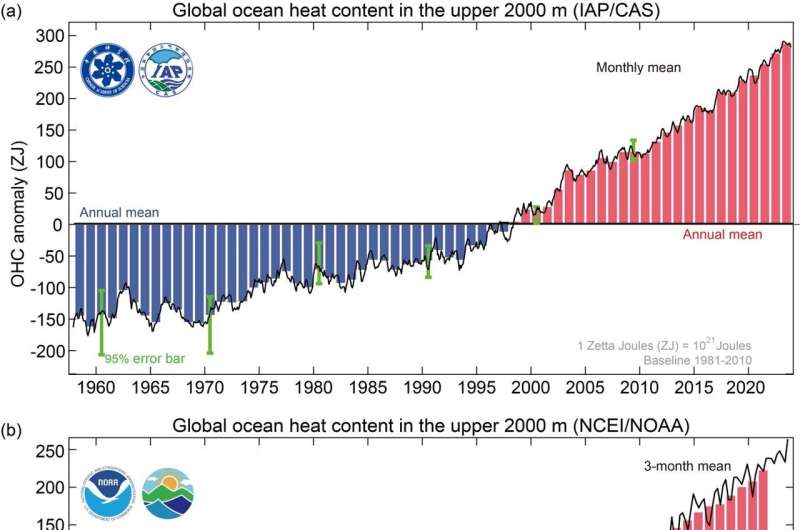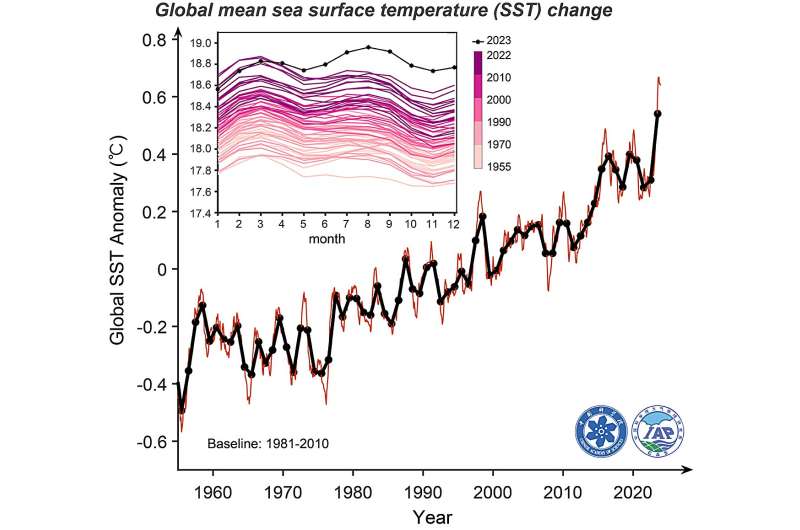This article has been reviewed according to Science X's editorial process and policies. Editors have highlighted the following attributes while ensuring the content's credibility:
fact-checked
peer-reviewed publication
trusted source
proofread
Ocean temperatures helped make 2023 the hottest year ever recorded

A multi-national team of scientists (China, U.S., New Zealand, Italy, and France) analyzes the temperature of the Earth annually. These scientists have found a fever that increases every year: For the past decade, each year has been hotter than the prior year in the ocean, and there are other changes in the ocean that also matter.
The ocean is an important part of the Earth's climate system—it covers 70% of the planet and absorbs about 90% of the heat from global warming. The ocean helps control the atmosphere—a warmer ocean leads to a warmer and moister atmosphere with wilder weather. The ocean also controls how fast the Earth's climate changes. To understand what has happened or what will happen to the planet, answers can be found in the ocean.
The data were obtained from two research teams: the Institute of Atmospheric Physics (IAP) at the Chinese Academy of Sciences (CAS) and the National Centers for Environmental Information of the National Oceanic and Atmospheric Administration (NOAA). Based on temperature measurements analyzed by the IAP, the world ocean heated by 15 zettajoules relative to 2022. According to NOAA, the heating was smaller, 9 zettajoules. Both groups reported another year of warming, but their magnitudes differed, as addressed below.
The final results are published on January 11, 2024 in Advances in Atmospheric Science.
What is a zettajoule? Annually, the entire globe consumes around half a zettajoule of energy to fuel our economies. A zettajoule is a huge amount of energy. Another way to think about this is that 15 zettajoules is enough energy to boil away 2.3 billion Olympic-sized swimming pools (50 m length, 25 m width and 2 m depth).
Why do the values differ? Scientists are working hard to resolve this, and early evidence points to the way each group handles the data. Big differences arise from "quality control" and how individual values are mapped onto a global grid. In particular, in a warming climate, new high ocean temperature measurements can be erroneously discarded.
"What this means is the warming might be greater than the numbers reported here," says Dr. Lijing Cheng from IAP/CAS, the lead author of the study.

The graphs show the ocean heating, since the late 1950s, according to the two datasets used in the study. Both show long-term warming. When showing long-term trends, scientists choose what is called a baseline to which other values are compared. In the graphs, the baseline is the average ocean temperature during 1981-2010. The bars shown in blue are colder than the 1981-2010 average—bars in red are warmer than the baseline.
The uppermost graph shows data from the IAP, whereas the lower images displays the analysis from NOAA. The two most important messages from the graphs are that there is a long-term warming in the ocean due to global warming and the two groups (IAP and NOAA) agree in terms of the long-term trends, even though data for a particular year may differ.

Ocean surface temperatures are off the chart. This blowout record is caused by both long-term global warming as well as short-term fluctuations of water temperatures in the Pacific Ocean (El Niño). Currently, both are contributing to the warmer waters at the ocean surface. A now-strong El Niño event in the tropical Pacific has built on global warming and climate change to warm ocean surface temperatures since May 2023. In turn, this modifies weather patterns around the world. Therefore, it is the relatively small year-to-year natural variability in OHC relative to the warming trend that makes OHC such a good indicator of climate change.
Rainfall and evaporation patterns are also changing, which alters ocean saltiness (salinity). Salty areas are getting saltier and fresh areas are getting fresher, with consequences for marine life and ocean currents.
Less dense, warm, and fresh waters near the surface tend to remain near the surface and are not able to carry heat and carbon dioxide to deeper layers. Scientists call such water "stratified." The newly published data shows that stratification continues to increase. This reduces oxygen in the ocean and its ability to take up carbon dioxide, with severe consequences for ocean plant and animal life.
A warming ocean also supercharges weather. The extra heat and moisture that enter into the atmosphere make storms more severe with heavier rain, stronger winds, and more significant flooding. There is tremendous damage around the world (approximately $200 billion USD each year in the U.S. alone) as well as major disruptions and loss of life.
These results highlight the need to promptly cease burning fossil fuels and stop adding more carbon dioxide into the atmosphere by decarbonizing the economy and switching to lower cost, cleaner, renewable sources like wind, solar and hydropower.
More information: New record ocean temperatures and related climate indicators in 2023, Advances in Atmospheric Sciences (2024). DOI: 10.1007/s00376-024-3378-5
Journal information: Advances in Atmospheric Sciences
Provided by Chinese Academy of Sciences




















